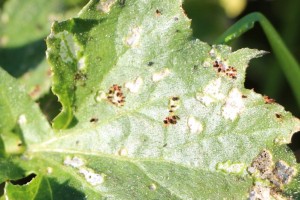Haleotydeus Destructor
 The name says it all, and we are infested with them. I first spotted them a month ago on my new asparagus spears, and have now found a whole host of them on the spinach and rocket in the vege beds on the other side of the property. There are also hoards of them on the capeweed in the goat paddock and we are not even at peak numbers yet. The main concern for us is newly sprouted oats, as in addition to the broad leaf weeds and clovers/legumes, they feed on ryegrass and young cereal crops, especially oats.
The name says it all, and we are infested with them. I first spotted them a month ago on my new asparagus spears, and have now found a whole host of them on the spinach and rocket in the vege beds on the other side of the property. There are also hoards of them on the capeweed in the goat paddock and we are not even at peak numbers yet. The main concern for us is newly sprouted oats, as in addition to the broad leaf weeds and clovers/legumes, they feed on ryegrass and young cereal crops, especially oats.
Imported from South Africa by mistake almost 100 years ago, the red-legged earth mite costs farmers in Australia almost a billion dollars in lost production every year. A member of the spider/arachnid family, adult mites are only about the size of a pinhead (up to 1 mm). The mites are often clumped together in large numbers, but you have to sneak up on them if you are trying to count them as they will drop to the ground and disperse if disturbed. They spend 90% of their time on the ground, so you have to spot them when they are eating first thing in the morning or on cloudy days.
The life cycle of the red-legged earth mite is a bit unusual. Three generations hatch each year, but only the third generation creates thicker walled eggs that can survive summer. The female dies with up to a hundred eggs inside her body, effectively becoming an egg case that is small and light enough to be carried by the wind. The eggs lie dormant in the soil and can withstand surface temperatures of 70C.
The hatching of the first generation is completely temperature sensitive and at least 6 consecutive cold days with temperatures below 20C are required. This first batch of mites grow for 3 to 8 weeks before producing thin walled winter eggs and dying. These eggs hatch almost immediately and pass through four nymphal stages over about 4-6 weeks. There is an apparent drop in numbers in July as the first generation dies and the second hatches. Numbers start building again in August and peak in early October.
Red legged earth mite organic control
Most of the advice for controlling them centres on chemical control, which is not a path we want to follow. So we are investigating other options. It looks like the guinea fowl may be eating the mites as they are spending a bit of time in the capeweed, but I don’t think that will be enough. The first plan will be on controlling the capeweed, as Red legged earth mites love to live on the ground in the shade of the leaves and congregate and reproduce in the flower heads. Farmers have had some success with heavy grazing of the capeweed, but as we don’t have any sheep yet, we will slash and whipper snipper where we can. I have also been trying to find out if steaming/burning the capeweed and surrounding soil after the eggs are laid in October would help with numbers next year. They can only survive up to 70 C/158F, so I think it would, but I haven’t found any discussion of this anywhere yet, although stubble burning has been shown to help in crops. For the vege beds, I have pulled out the spinach and infect rocket and will sterilise the bed with black plastic next summer. It will also be important to keep the capeweed away from the vege beds. I will look at “flame thrower” butane/propane blow torches like the Hot Devil and steam wands like the Wagner that can produce a good head of steam for a long time.

Facebook